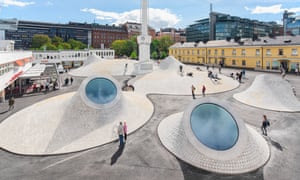Designed by three radical young architects when they were still students, the Lasipalatsi was intended to be temporary, giving them a freer rein to let rip and allowing them to incorporate such details as first outdoor neon sign in Finland. Eighty years on, the streamlined white building provides a stylish foil to the futuristic underworld that JKMM has concocted.
Entering off the city’s main Mannerheimintie avenue, visitors are greeted with a big picture window that frames one of the new mounds in the square beyond before descending down a broad staircase to a bright white foyer. The ceiling is covered with spirals of white illuminated fabric that gently throb, giving the impression of being beneath some ethereal cloud canopy (a welcome sight in Helsinki’s dark winter months), while two great conical voids plunge down from the piazza, framing views of surrounding buildings through their circular windows. It is a world apart from the former home of the Amos Anderson Art Museum, founded on the legacy of the property speculator turned media mogul and patron of the arts in his former newspaper offices in 1965.
“Art used to be something you hung on the wall and went respectfully to contemplate,” says the museum’s director, Kai Kartio. “Today it is increasingly interactive and conversational, something people make and experience together. We realised that if we wanted to meet the challenges of the future, we had to have something different from our charming old office building.”
The resulting space is as far away from the 1913 art nouveau block as could be imagined. It feels like a group of conjoined circus tents that form a single undulating ceiling above the expansive hall, clad in a continuous skin of circular white disks, and soaring up and swooping down from the gaping round roof-lights. Or at least that’s what you would see if the place hadn’t been divided up and blacked out for the opening exhibition, Massless, a virtual reality spectacular by Japanese group TeamLab.




